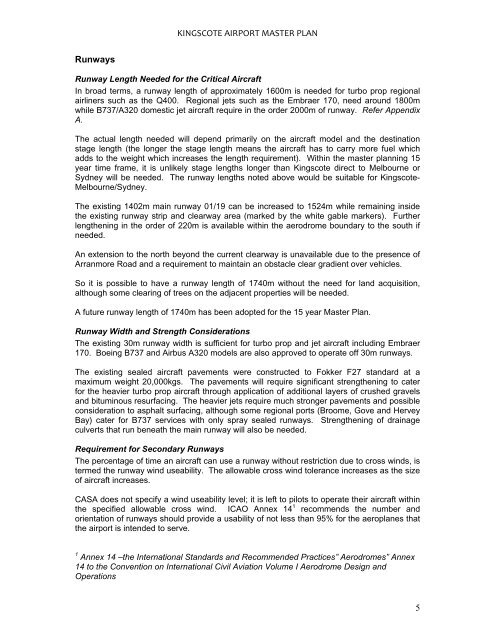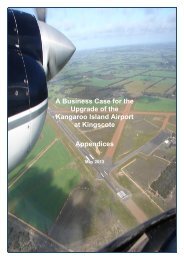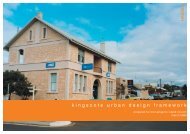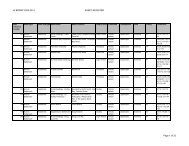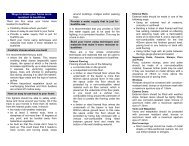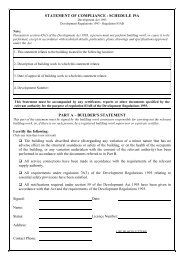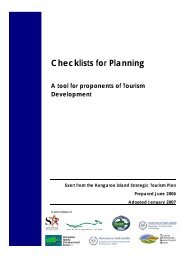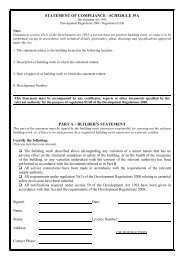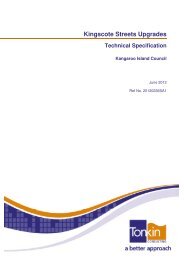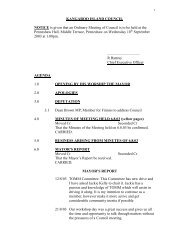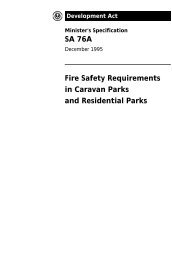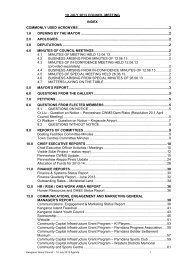Kingscote Airport Master Plan Apr 2010 - Kangaroo Island Council
Kingscote Airport Master Plan Apr 2010 - Kangaroo Island Council
Kingscote Airport Master Plan Apr 2010 - Kangaroo Island Council
You also want an ePaper? Increase the reach of your titles
YUMPU automatically turns print PDFs into web optimized ePapers that Google loves.
KINGSCOTE AIRPORT MASTER PLAN<br />
Runways<br />
Runway Length Needed for the Critical Aircraft<br />
In broad terms, a runway length of approximately 1600m is needed for turbo prop regional<br />
airliners such as the Q400. Regional jets such as the Embraer 170, need around 1800m<br />
while B737/A320 domestic jet aircraft require in the order 2000m of runway. Refer Appendix<br />
A.<br />
The actual length needed will depend primarily on the aircraft model and the destination<br />
stage length (the longer the stage length means the aircraft has to carry more fuel which<br />
adds to the weight which increases the length requirement). Within the master planning 15<br />
year time frame, it is unlikely stage lengths longer than <strong>Kingscote</strong> direct to Melbourne or<br />
Sydney will be needed. The runway lengths noted above would be suitable for <strong>Kingscote</strong>-<br />
Melbourne/Sydney.<br />
The existing 1402m main runway 01/19 can be increased to 1524m while remaining inside<br />
the existing runway strip and clearway area (marked by the white gable markers). Further<br />
lengthening in the order of 220m is available within the aerodrome boundary to the south if<br />
needed.<br />
An extension to the north beyond the current clearway is unavailable due to the presence of<br />
Arranmore Road and a requirement to maintain an obstacle clear gradient over vehicles.<br />
So it is possible to have a runway length of 1740m without the need for land acquisition,<br />
although some clearing of trees on the adjacent properties will be needed.<br />
A future runway length of 1740m has been adopted for the 15 year <strong>Master</strong> <strong>Plan</strong>.<br />
Runway Width and Strength Considerations<br />
The existing 30m runway width is sufficient for turbo prop and jet aircraft including Embraer<br />
170. Boeing B737 and Airbus A320 models are also approved to operate off 30m runways.<br />
The existing sealed aircraft pavements were constructed to Fokker F27 standard at a<br />
maximum weight 20,000kgs. The pavements will require significant strengthening to cater<br />
for the heavier turbo prop aircraft through application of additional layers of crushed gravels<br />
and bituminous resurfacing. The heavier jets require much stronger pavements and possible<br />
consideration to asphalt surfacing, although some regional ports (Broome, Gove and Hervey<br />
Bay) cater for B737 services with only spray sealed runways. Strengthening of drainage<br />
culverts that run beneath the main runway will also be needed.<br />
Requirement for Secondary Runways<br />
The percentage of time an aircraft can use a runway without restriction due to cross winds, is<br />
termed the runway wind useability. The allowable cross wind tolerance increases as the size<br />
of aircraft increases.<br />
CASA does not specify a wind useability level; it is left to pilots to operate their aircraft within<br />
the specified allowable cross wind. ICAO Annex 14 1 recommends the number and<br />
orientation of runways should provide a usability of not less than 95% for the aeroplanes that<br />
the airport is intended to serve.<br />
1 Annex 14 –the International Standards and Recommended Practices” Aerodromes” Annex<br />
14 to the Convention on International Civil Aviation Volume I Aerodrome Design and<br />
Operations<br />
5


